Search
- Page Path
- HOME > Search
Research Note
- [English]
- Pilot evaluation of a cooking-based nutrition education program to promote vegetable intake among children in Seoul, South Korea: a single-group pre–post study
- Sil-Ah Kim, Su-Jin Lee, Min-Ah Kim, Ji-Eun Oh, Sohyun Park, Hyun-Joo Ryou, Ji-Yun Hwang
- Korean J Community Nutr 2025;30(4):249-260. Published online August 29, 2025
- DOI: https://doi.org/10.5720/kjcn.2025.00220
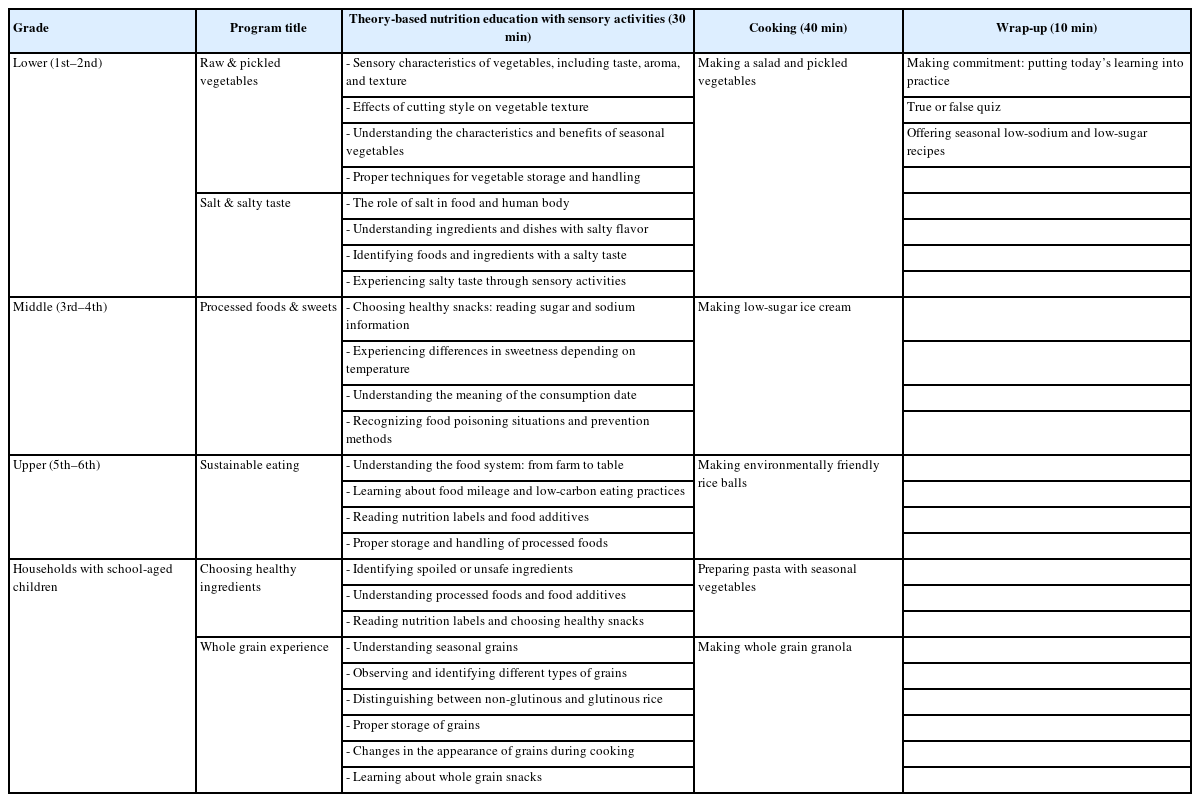
-
 Abstract
Abstract
 PDF
PDF PubReader
PubReader ePub
ePub - Objectives
Food neophobia in children is often associated with limited exposure and familiarity to some foods. Cooking-based nutrition education (CBNE), which promotes acceptance through direct experience, may support the development of healthy eating habits. This study aimed to develop and implement a standardized CBNE program for school-aged children in Seoul, South Korea, and to evaluate its effectiveness by assessing changes in raw vegetable intake. Raw vegetable intake is an early indicator of the effectiveness of nutrition education on diverse topics in promoting healthy eating habits.
Methods
A single-group pre–post study was conducted with 37 children aged 6–11 years who participated in a 2-day CBNE program in October 2023. The participants completed pre- and post-education questionnaires and raw vegetable intake assessments. Four low-preference vegetables (bell pepper, carrot, cucumber, and tomato) were selected and served raw (25 g each) before and after the program. Intake changes were analyzed using paired t-tests, and Pearson’s correlation and hierarchical regression analyses were performed to identify predictors.
Results
Total raw vegetable intake significantly increased post-education (P = 0.008), particularly for carrots (P = 0.023). By subgroup, raw vegetable intake significantly increased in girls, upper-grade students, and those who consumed four or more vegetable side dishes per meal. Hierarchical regression analysis revealed that while vegetable preference was initially significant, vegetable-related experiences (β = 0.395, P = 0.026) and diversity of vegetable side dishes per meal (β = 0.403, P = 0.032) were stronger predictors in the final model (adj R2 = 0.333).
Conclusion
The CBNE program may enhance vegetable intake in children. Although preference remained the strongest individual factor, vegetable experience and the diversity of vegetable side dishes per meal had a greater combined effect. These findings underscore the importance of repeated and diverse exposure, not only by supporting previous studies that link such exposure to increased intake but also by suggesting that environmental support may be essential for sustaining healthy eating habits.
- 468 View
- 23 Download

Research Articles
- [Korean]
- Survey on consumer perceptions, health benefits and preferences of kindergarten and school foodservices in Korea, including related keywords reported in newspaper: a mixed-methods study
- Gyoungok Gang, Chaewon Park, Hyeja Chang
- Korean J Community Nutr 2025;30(4):309-320. Published online August 29, 2025
- DOI: https://doi.org/10.5720/kjcn.2025.00199
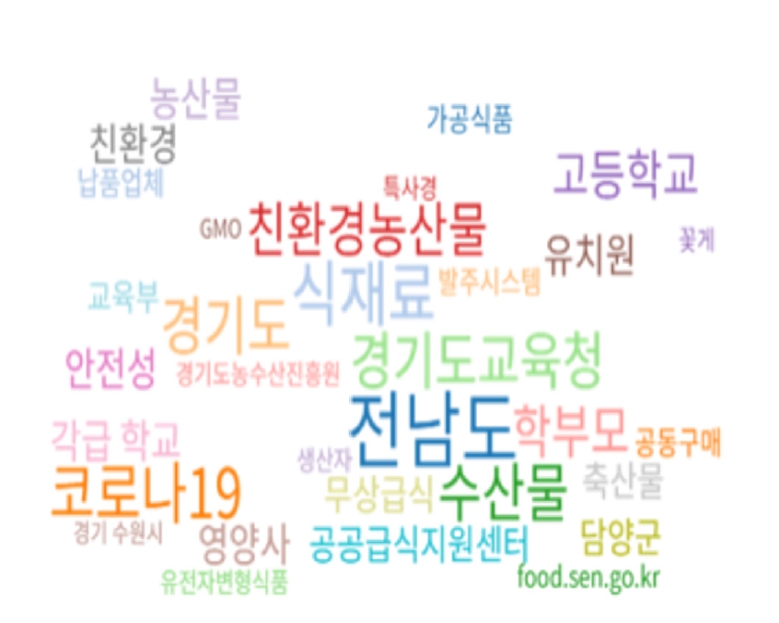
-
 Abstract
Abstract
 PDF
PDF PubReader
PubReader ePub
ePub - Objectives
With the rapid development of social culture, the perception of kindergarten and school foodservice, as well as opinions on its health benefits, has changed significantly. However, research on this topic remains scarce. We conducted a survey in South Korea on consumers’ perceptions, healthiness, and preferences regarding kindergarten and school foodservice.
Methods
With the nationwide cooperation of 17 city and provincial education offices, online and offline surveys were conducted targeting the parents of kindergarten and lower-grade elementary school children, as well as upper-grade elementary, middle, and high school students. In addition, keywords in newspaper reports were analyzed using the Big Kinds platform. A total of 532 valid questionnaires were collected, and statistical analysis was performed using IBM SPSS Statistics version 27.0 (IBM Co.).
Results
The average age of the parents and students was 40 and 12.5 years, respectively, with 36.4% of the students attending schools in the Seoul and Gyeonggi areas. The main keywords reported in newspaper articles, as analyzed using the Big Kinds platform, were “eco-friendly agricultural products,” “food ingredients,” “safety,” and “marine products.” The perception of kindergarten and school foodservice was very positive, especially regarding the attributes of safe ingredient use (4.44), menu variety (4.29), cafeteria cleanliness (4.31), cleanliness of plates, spoons, and utensils (4.24), thorough hygiene management (4.2), nutritional excellence (4.24), and support for proper eating habits (4.18). The healthiness of school foodservice was highly rated, although there is still room for improvement in terms of “not serving fried foods more than twice a week”. In terms of preference for school meals, the most preferred items were meat side dishes, followed by chicken, noodles, fried food, beverages, and bread. In contrast, soybean paste soup, vegetables, and mixed-grain rice received relatively low preference.
Conclusion
The results described above may be used to develop educational programs or policies that inform students and parents about the goals of school foodservice and help address common misunderstandings.
- 452 View
- 13 Download

- [English]
- Associations between diet quality and regional factors in Korea vary according to individuals’ characteristics: a cross-sectional study
- Hyunmi Han, Clara Yongjoo Park, Jeonghwa Lee
- Korean J Community Nutr 2025;30(4):274-285. Published online August 29, 2025
- DOI: https://doi.org/10.5720/kjcn.2025.00157

-
 Abstract
Abstract
 PDF
PDF Supplementary Material
Supplementary Material PubReader
PubReader ePub
ePub - Objectives
Although diet quality is known to be associated with environment and individuals’ characteristics, these have not been studied together. We determined the association of diet quality with regional factors stratified by individuals’ sociodemographic characteristics.
Methods
This study used nationally representative survey data on regional factors (2010–2020) and the Korea National Health and Nutrition Examination Survey data on individuals’ sociodemographic characteristics (2013–2018). Community-dwelling Koreans aged ≥ 20 were included (n = 26,853). Regions were categorized into metropolitan cities or provinces and subsequently according to regional factors (level of educational attainment, income per capita, food security status, physical activity facilities, time to the nearest large retailer, and internet use of the region). Individuals’ sociodemographic characteristics included age, education status, income, and number of household members. Diet quality was assessed using the Korean Healthy Eating Index (KHEI).
Results
In the entire population, education status of metropolitan cities was positively associated with the KHEI. Shorter time to retailers and higher internet use were positively associated with the KHEI in metropolitan residents with higher income levels but negatively associated with the KHEI in those with lower income status. Among provincial residents with a low education status or income, regional physical activity facilities were positively associated with the KHEI.
Conclusion
The association between diet quality and regional factors varied depending on the resident’s sociodemographic characteristics. Both regional and individual sociodemographic factors must be considered to address gaps in nutritional equity.
- 348 View
- 11 Download

- [Korean]
- Behavioral intention toward planetary health diet among adult users of government worksite cafeterias in Seoul, South Korea: a mixed-methods study based on the theory of planned behavior and focus groups interviews
- Ji-Won Kang, Su-Jin Lee, Sil-Ah Kim, Ji-Yun Hwang
- Korean J Community Nutr 2025;30(3):224-236. Published online June 30, 2025
- DOI: https://doi.org/10.5720/kjcn.2025.00108
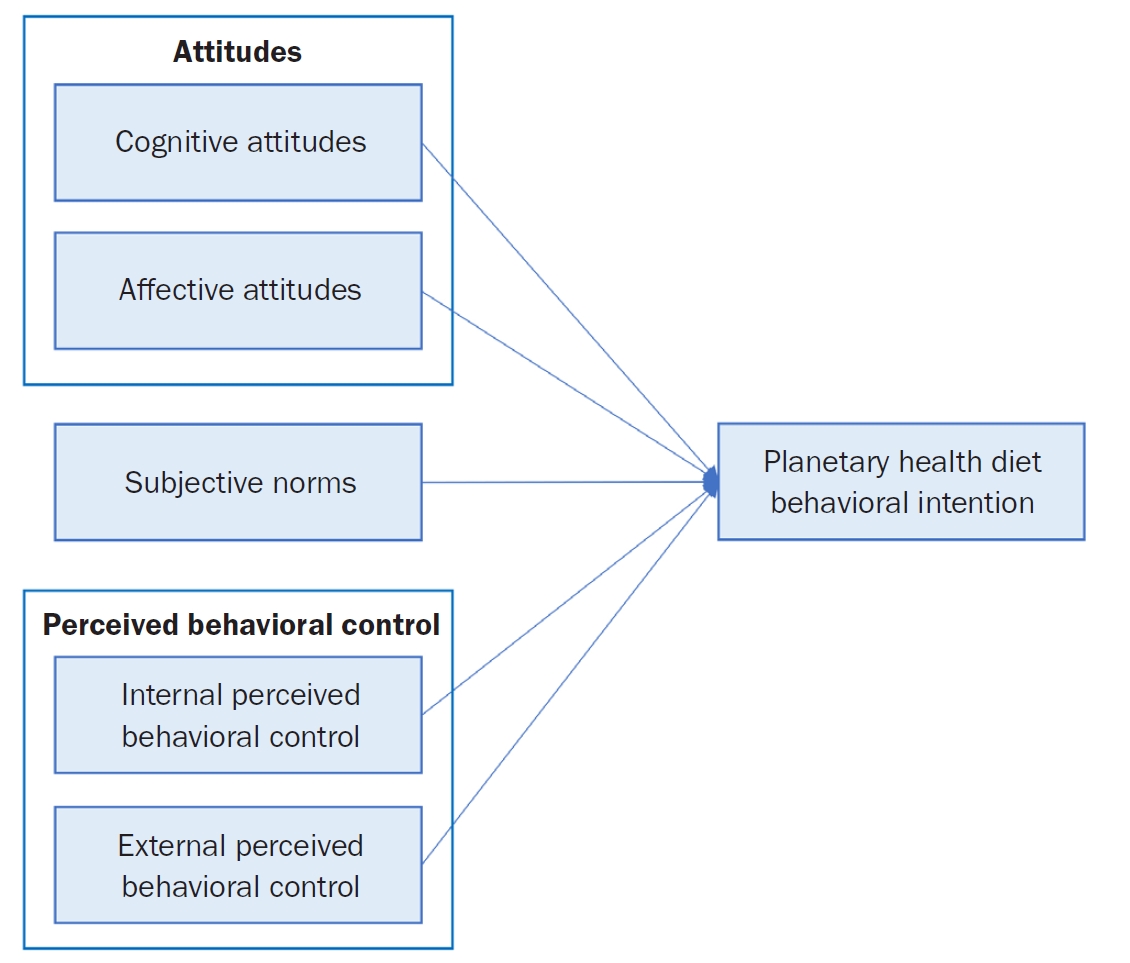
-
 Abstract
Abstract
 PDF
PDF PubReader
PubReader ePub
ePub - Objectives
To reduce urban carbon emissions, in this study, we aimed to suggest strategies for disseminating the planetary health diet (PHD) guidelines to adult cafeterias in a government worksite in Seoul based on the theory of planned behavior (TPB) and focus group interviews (FGI).
Methods
A total of 132 adults who worked at a government worksite in Seoul and used its cafeteria were included for a TPB-based survey. Factor analyses and multiple regression were used to investigate the relationships between attitude (cognitive•affective), subjective norms, and perceived behavioral control (PBC, internal•external) and the behavioral intention to adopt the PHD. To identify the contextual factors related to PHD dissemination, 14 participants underwent in-depth interviews.
Results
Affective attitudes and PBC (internal•external) constructs of the TPB were significantly related with the intention to adopt PHD: external PBC (β = 0.324, P < 0.001), internal PBC (β = 0.269, P < 0.01), and affective attitudes (β = 0.226, P < 0.05). The FGI results highlighted the insufficiency of simply providing healthy meals to encourage the adoption of PHDs, but that menu development and natural acceptance strategies are needed to increase palatability. In addition, the need for strategies to promote PHDs at an organizational level was identified, as it is directly influenced by the company of partners with whom one dines. Furthermore, users' perceptions of how “Meals for the Planet” are delivered and suggestions for its improvement were also interpreted.
Conclusion
Our results suggest that users' beliefs, convictions, and emotions are important while promoting or educating individuals about sustainable PHDs. Our findings are expected to help local governments or private group cafeterias that wish to introduce PHDs in the future, given the growing importance of environmentally conscious eating.
- 675 View
- 47 Download

- [English]
- Healthy eating intentions among adults in China: a cross-sectional study of northern and southern regions and city tiers based on the theory of planned behavior
- Yi Jiang, Ji-Yun Hwang
- Korean J Community Nutr 2025;30(2):114-126. Published online April 29, 2025
- DOI: https://doi.org/10.5720/kjcn.2025.00087
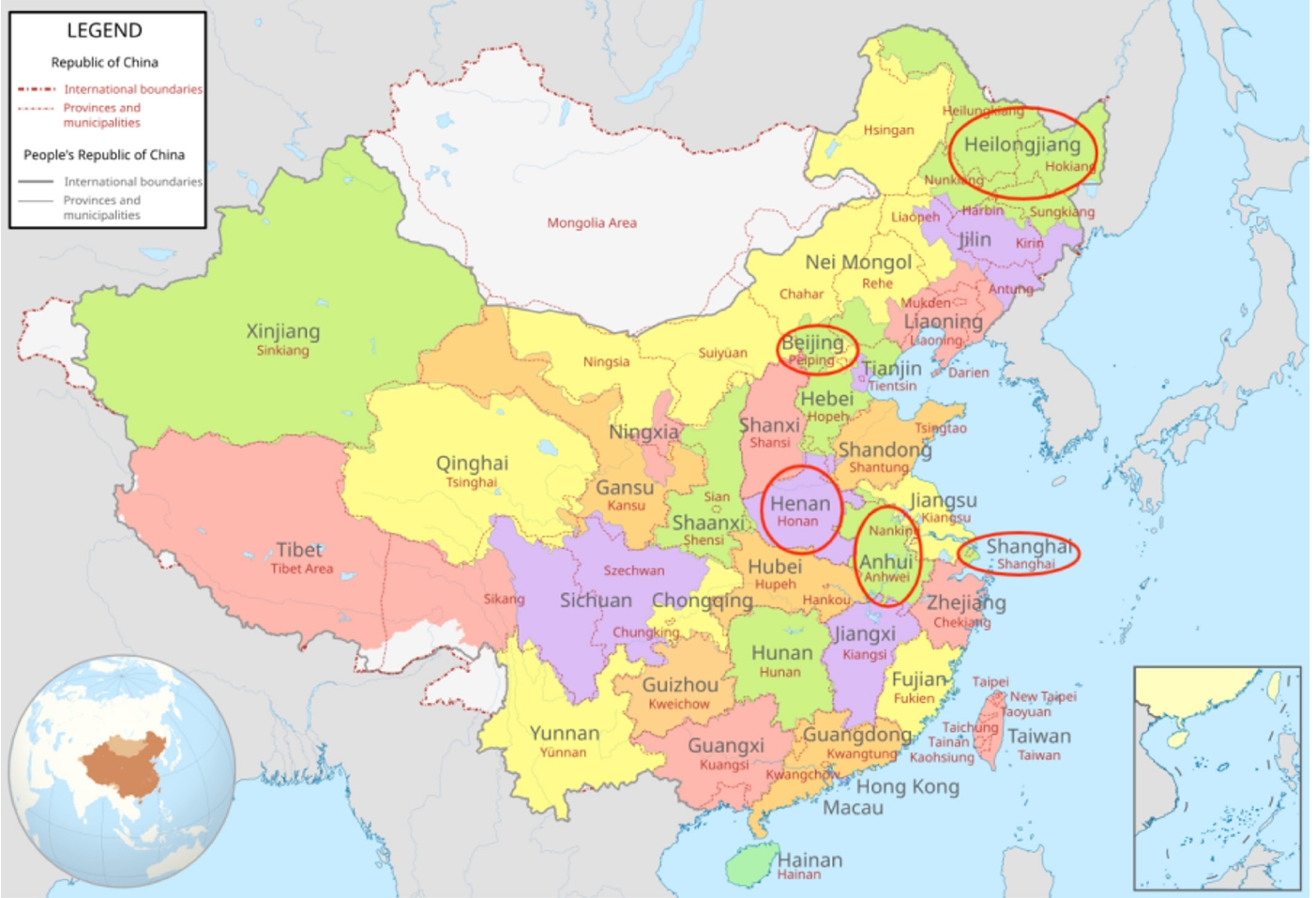
-
 Abstract
Abstract
 PDF
PDF PubReader
PubReader ePub
ePub - Objectives
The theory of planned behavior (TPB) has been widely employed to predict healthy eating intentions. Regional differences may affect dietary habits, health status, and personality traits, whereas variations in urbanization influence accessibility to fresh and healthy food, thereby impacting TPB components. This study aimed to explore whether regional differences between northern and southern China including city-tier development are associated with healthy eating intentions among Chinese adults.
Methods
The study included data from 2,114 Chinese adults aged 19–64 years collected between 2019 and 2023. Participants were categorized by geographic region (north or south) and city-tier status (first-tier or other).
Results
Compared to individuals from northern first-tier cities, those from southern regions exhibited stronger attitudes, perceived behavioral control (PBC), and intention to eat healthily. Participants from other cities in the north had more positive attitudes, subjective norms, PBC, and intentions to participate in healthy eating. Furthermore, residents of southern cities revealed weaker subjective norms than those of cities in the north. The adjusted odds ratio (OR) for compliance with intention to engage in healthy eating was higher among participants from other cities in both the north and south compared to those from northern first-tier cities (northern other cities: OR = 2.43, 95% confidence interval [CI]: 1.49–3.97, P < 0.001; southern other cities: OR = 1.95, 95% CI: 1.08–3.51, P = 0.027). No significant differences existed among the subjects from first-tier cities according to their geographic regions. These trends remained consistent even after including the interaction term between geographic regions and city-tier classification.
Conclusion
These findings underscore the complexity of regional variations influencing dietary intentions and indicate that tailored health promotion strategies should incorporate regional characteristics. Future research should explore underlying factors, including regional cultural influences, to better inform policies and interventions. -
Citations
Citations to this article as recorded by- Beyond taste: Unpacking the drivers of plant-based diet adoption
Md. Asaduzzaman Babu
Food and Humanity.2025; 5: 100779. CrossRef
- Beyond taste: Unpacking the drivers of plant-based diet adoption
- 952 View
- 23 Download
- 1 Crossref

- [Korean]
- Effects of night eating on oral health characteristics and symptoms of poor oral health in adolescents: a cross-sectional study using the 18th Korea Youth Risk Behavior Survey
- Seung–Hee Hong
- Korean J Community Nutr 2025;30(2):150-162. Published online April 29, 2025
- DOI: https://doi.org/10.5720/kjcn.2025.00038
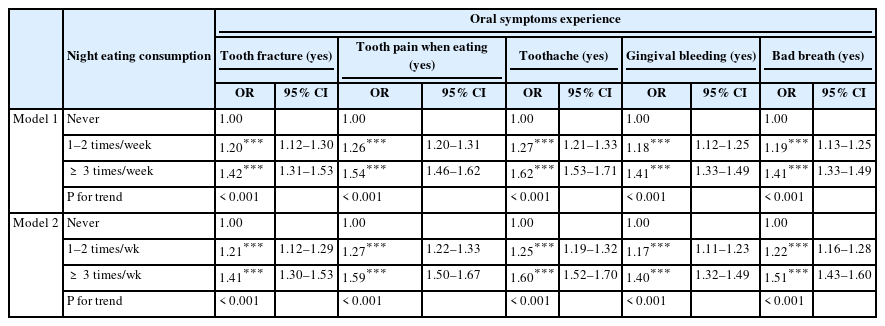
-
 Abstract
Abstract
 PDF
PDF PubReader
PubReader ePub
ePub - Objectives
To determine the association between night eating habits and oral health in adolescents.
Methods
Data from the 18th Korea Youth Risk Behavior Survey conducted in 2022 were analyzed. The study included 51,850 middle and high school students and assessed the frequency of night eating per week, dietary habits, oral health characteristics, and factors affecting the presence of symptoms of poor oral health.
Results
Almost thirty-seven percent (36.6%) of Korean adolescents have eaten at night one to two times per week and 23.0% more than three times per week. An increased frequency of night eating was associated with poor dietary habits. Adolescents who consumed more at night were less likely to have breakfast, drink water, and eat fruit, while their consumption of fast food, sweet drinks, and high-caffeine drinks increased (P < 0.001). An increased frequency of night eating was also associated with poor oral health. In a logistic regression analysis, more frequent night eaters were significantly less likely to brush their teeth at least three times per day (odds ratio [OR], 0.78; 95% confidence interval [CI], 0.75–0.82; P for trend < 0.001), and brush their teeth before going to sleep (OR, 0.70; 95% CI, 0.65–0.75; P for trend < 0.001), while they were more likely to experience sealant (OR, 1.19; 95% CI, 1.13–1.26). More frequent night eaters were significantly more likely to have tooth fracture (OR, 1.41; 95% CI, 1.30–1.53; P for trend < 0.001), tooth pain when eating (OR, 1.59; 95% CI, 1.50–1.67; P for trend < 0.001), toothache (OR, 1.60; 95% CI, 1.52–1.70), and bad breath (OR, 1.51; 95% CI, 1.43–1.60).
Conclusion
Our findings suggest that frequent night eating is linked to symptomatically poor oral health in adolescents. Therefore, oral health education programs related to dietary habits are necessary to reduce the potential of night eating to negatively influence dietary habits and oral health.
- 1,339 View
- 49 Download

- [English]
- Relationship between self-care and health-related behaviors among Korean adults: a cross-sectional study
- EunJung Lee, Jin A Jang, Ji-Myung Kim
- Korean J Community Nutr 2025;30(2):103-113. Published online April 29, 2025
- DOI: https://doi.org/10.5720/kjcn.2024.00255

-
 Abstract
Abstract
 PDF
PDF PubReader
PubReader ePub
ePub - Objectives
This study investigated the relationship between self-care and health-related behaviors such as medication use, dietary supplementation, dietary habits, and physical activity among Koreans aged 20–60 years.
Methods
Data from a total of 300 participants (150 men and 150 women) living in Seoul and Gyeonggi provinces in Korea were analyzed to assess the relationship between health behaviors and dietary supplements (DSs) related to self-care. Based on self-care levels, the participants were classified into three groups: low (LS, n = 124), medium (MS, n = 78), and high (HS, n = 98).
Results
DSs (P < 0.001), physical activity (P < 0.001), recognizing the perceived health benefits of self-care (P < 0.001), self-care when sick (P = 0.039), and the reasons for self-care (P = 0.028) differed among the self-care groups. Daily diet frequency (P = 0.001), breakfast frequency (P = 0.026), regular exercise (P < 0.001), DSs use rate (P < 0.001), DSs use frequency (P = 0.013), and total dietary behavior score (P < 0.001) also differed significantly depending on the degree of self-care. The degree of self-care was significantly and positively correlated with DSs intake (r = 0.377, P < 0.001), physical activity (r = 0.433, P < 0.001), and total dietary behavior score (r = 0.185, P < 0.01).
Conclusion
The results demonstrated that the degree of self-care was related to DSs, physical activity, and total dietary behavior scores in Korean adults. Additionally, self-care capacity should be increased through health-related behaviors based on health education programs.
- 971 View
- 47 Download

- [Korean]
- Application of a living lab model to an evidence-based reduced-sodium healthy eating practice program in Korea: a pre-post study
- Jung-Hyun Kim, Eugene Shim, Min Sook Kyung, Sooyoun Kwon, Hyoung Su Park, Jae-Heon Kang
- Korean J Community Nutr 2025;30(1):53-63. Published online February 28, 2025
- DOI: https://doi.org/10.5720/kjcn.2024.00346
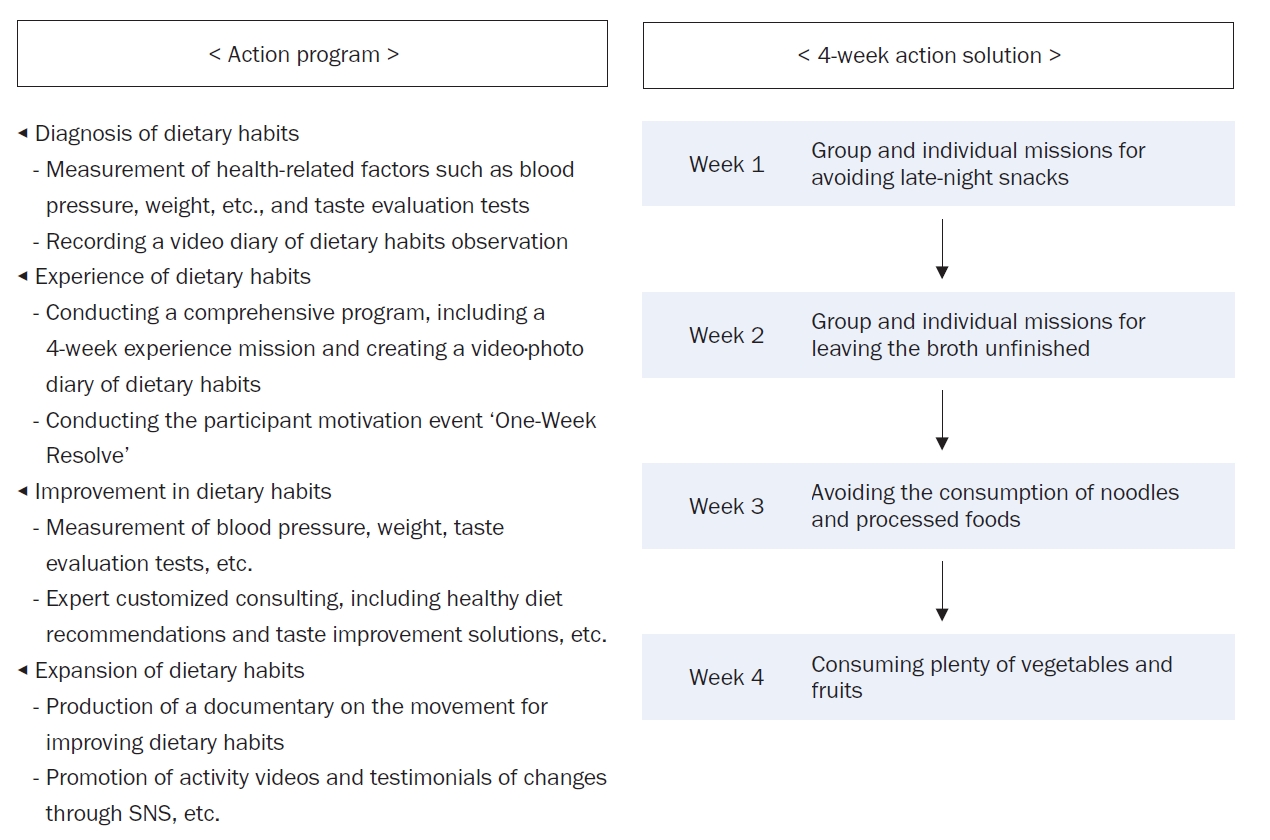
-
 Abstract
Abstract
 PDF
PDF PubReader
PubReader ePub
ePub - Objectives
To apply a healthy dietary program with reduced sodium intake, developed using data from the Korea National Health and Nutrition Examination Survey (KNHANES), focusing on the sodium intake level and eating patterns.
Methods
The program was implemented using a living lab model, an open innovation ecosystem for user-centered problem-solving. Analysis of the KNHANES data revealed that older age groups had a low energy intake but a high sodium intake, particularly among those who frequently dined out. The program was designed to improve sodium-reduction literacy and enhance practical competency. Over four weeks, 40 participants tracked their dietary intake and worked with a clinical nutritionist through a process of diagnosis, experience, improvement, and expansion. A self-administered survey was conducted before and after the program to assess effectiveness.
Results
Participants were four teenagers (10%), 26 in their twenties (65%), and 10 aged ≥ 30 years (25%), with eight males (20%) and 32 females (80%). Post-program analysis showed significant improvements in sodium-related nutrition knowledge (P < 0.01), with increased agreement on adopting low-sodium intake practices (e.g., interest in sodium content, choosing lower-sodium foods). Nutrient intake analysis showed a decrease in energy, carbohydrates, lipids, and proteins (P < 0.001), with sodium intake decreasing from 3,382.37 mg/d to 2,119.05 mg/d (P < 0.001).
Conclusion
The community-based, living lab model for the sodium-reduction program effectively improved participant sodium-reduction literacy and practical competency, suggesting that step-by-step, autonomous learning, can reduce sodium intake and promote healthier eating habits.
- 1,285 View
- 45 Download

- [Korean]
- Development and application of a dietary program to reduce sugar intake using a living lab approach in Korea: an intervention study
- Jung-Hyun Kim, Min Sook Kyung, Seul Ki Choi
- Korean J Community Nutr 2024;29(6):504-513. Published online December 31, 2024
- DOI: https://doi.org/10.5720/kjcn.2024.00318
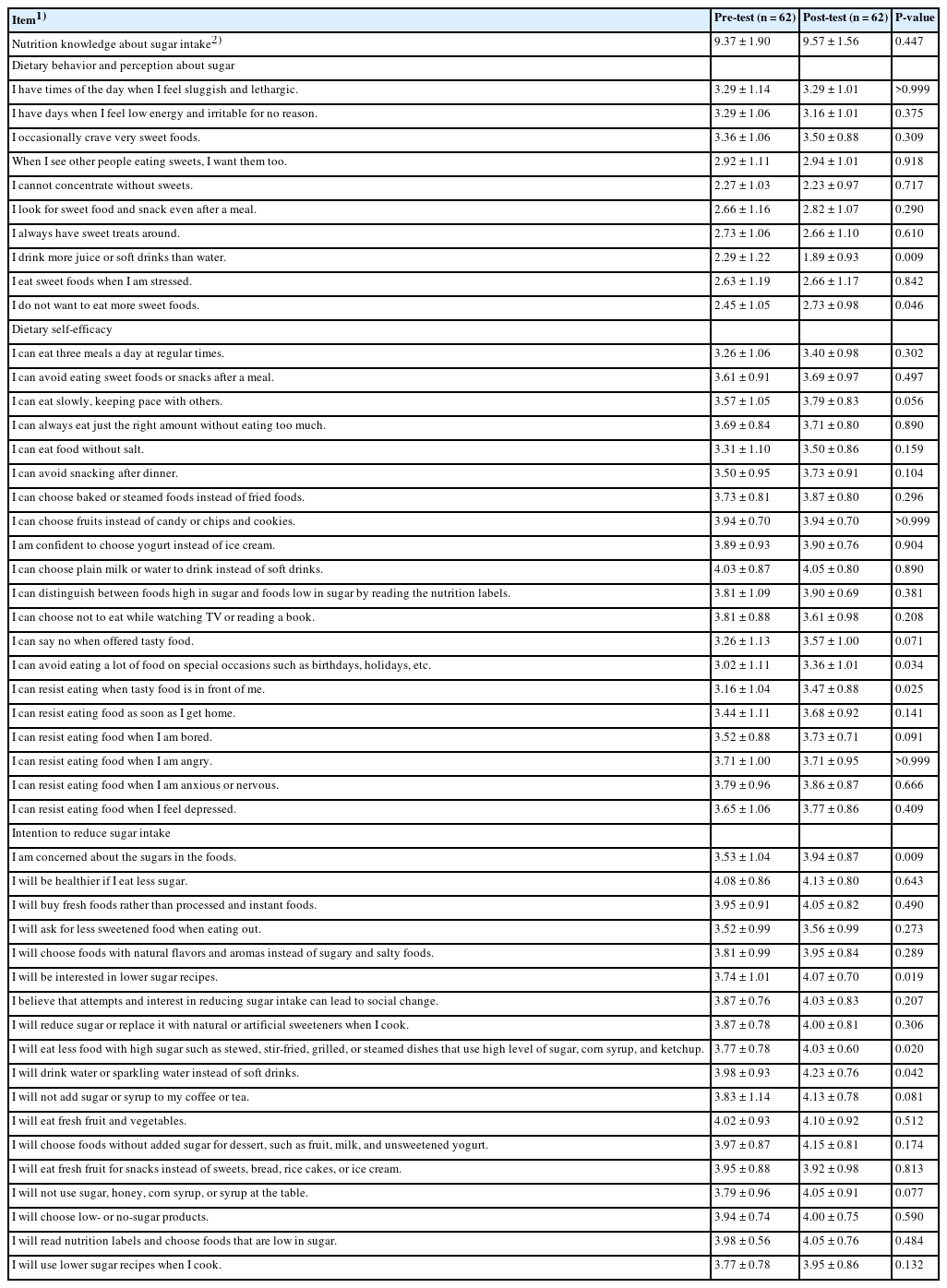
-
 Abstract
Abstract
 PDF
PDF PubReader
PubReader ePub
ePub - Objectives
This study aimed to develop and apply a dietary program to reduce sugar intake among community residents using a Living Lab approach.
Methods
We developed and applied a community-based dietary program to reduce sugar intake. Participants were recruited from community organizations, including a children’s food service management center, elementary to high schools, a university, a family center, a community health center, and an elderly welfare center. The dietary program was conducted in two phases; start and next levels. The start level included a pre-assessment of dietary behaviors and participation in educational platforms, whereas the next level included activities using educational platforms, tailored mission and feedback, and pre- and post-surveys. Extension educators at each community organization implemented the dietary program following organization-specific guidelines. Changes in participants’ nutrition knowledge, dietary behaviors and perceptions, self-efficacy, intention to reduce sugar intake, and participants’ program satisfaction were analyzed using paired t-tests.
Results
In total, 1,238 and 339 individuals participated in the start and next level, respectively. Participants reported significantly lower scores on dietary behavior items regarding drinking more juice or soft drinks after program participation (P = 0.009) and craving sweet foods (P = 0.046). They reported a higher intention to take interest in sugar content in food (P = 0.009) and lower-sugar recipes (P = 0.019), eat less food with high sugar content (P = 0.020), and drink water or sparkling water instead of soft drinks (P = 0.042). Nutrition knowledge did not significantly change after program participation. Program satisfaction significantly increased from the start level to the next level (P<0.050).
Conclusion
This study showed the potential of using a Living Lab approach to implement community-wide dietary interventions. Further research is required to evaluate the effectiveness of the Living Lab approach in various community settings.
- 1,261 View
- 53 Download

- [Korean]
- Biochemical characteristics, nutrient intakes, and chronic disease risk according to the dietary fat energy ratio in middle-aged Korean: a cross-sectional study using data from the 7th (2016–2018) Korean National Health and Nutrition Examination Survey
- Ga-Hyeon Jeong, Sook-Bae Kim
- Korean J Community Nutr 2024;29(6):528-540. Published online December 31, 2024
- DOI: https://doi.org/10.5720/kjcn.2024.00304
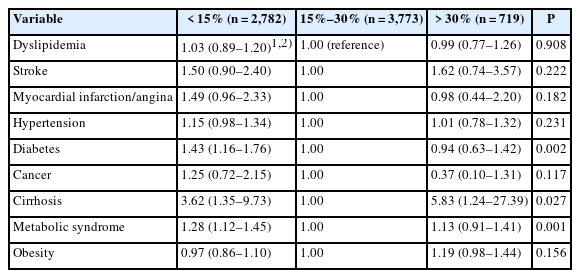
-
 Abstract
Abstract
 PDF
PDF PubReader
PubReader ePub
ePub - Objectives
This study aimed to examine health-related characteristics and chronic disease risk in middle-aged Koreans based on their fat energy intake ratio.
Methods
We analyzed data from 7,274 Koreans aged 40–64 years using the 7th (2016–2018) Koreans National Health and Nutrition Examination Survey. Participants were classified into three groups based on their fat energy intake ratio: insufficient (< 15%), adequate (15%–30%), and excessive (> 30%). We assessed their socio-demographic characteristics; lifestyle characteristics; biochemical characteristics; quantitative and qualitative nutrient intakes, measured using dietary reference intakes for Koreans and index of nutrition quality (INQ); and chronic disease risk.
Results
Significant differences were observed between the groups in age, gender, income, education, and residence region. The insufficient group had the highest proportion of older adults, male, lower income, rural residents, and lower education levels. The groups differed significantly in lifestyle characteristics, with the insufficient group having the highest rates of no walking, heavy drinking, smoking, and poor subjective health perception. Biochemical characteristics in the insufficient group exhibited the lowest levels for fasting blood glucose, hemoglobin A1c, and triglycerides. Significant differences were found in both the quantitative and qualitative intake of nutrients. The insufficient group had the lowest intake of most nutrients except fiber, whereas the excessive group had the lowest fiber intake. Based on the INQ, vitamin A and Ca were the lowest in the insufficient group, and vitamin C and folic acid were the lowest in the excessive group. The risk of diabetes mellitus and metabolic syndrome was highest in the deficient group, and the risk of liver cirrhosis was highest in the excessive group.
Conclusion
Insufficient or excessive fat energy intake ratio negatively affects nutrient intake and chronic disease risk. Fat energy intake of 15%–30% is important for improving nutrient intake and managing chronic diseases, such as diabetes mellitus, metabolic syndrome, and liver cirrhosis. We suggest that education and an appropriate social environment are necessary to ensure this fat energy intake. -
Citations
Citations to this article as recorded by- Study on the Optimization of Manufacturing Conditions for Traditional Potato Bugak Using Response Surface Methodology
Yu Hyeon Jo, Jeong Ok Rho
Journal of the East Asian Society of Dietary Life.2025; 35(1): 60. CrossRef
- Study on the Optimization of Manufacturing Conditions for Traditional Potato Bugak Using Response Surface Methodology
- 968 View
- 37 Download
- 1 Crossref

- [English]
- Trends in growth and nutritional status of Korean toddlers and preschoolers: a cross-sectional study using 2010–2021 Korea National Health and Nutrition Examination Survey data
- Annisa Turridha, Jae Eun Shim
- Korean J Community Nutr 2024;29(6):480-491. Published online December 31, 2024
- DOI: https://doi.org/10.5720/kjcn.2024.00241
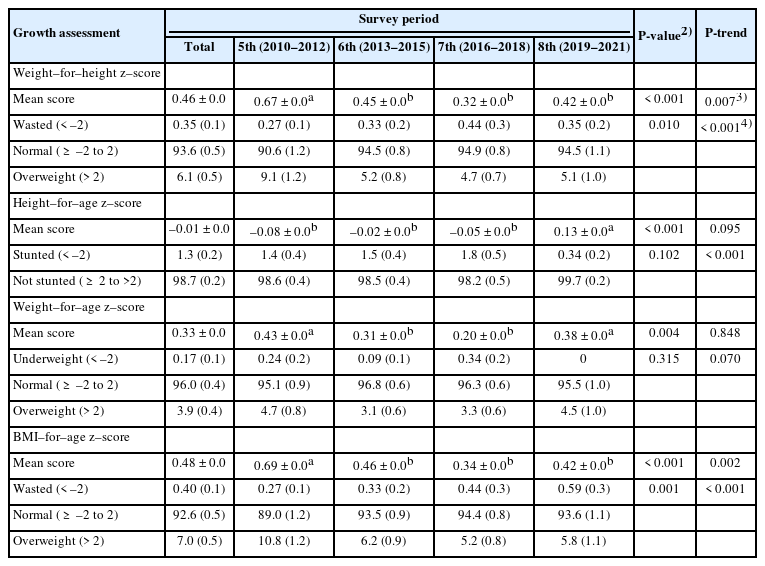
-
 Abstract
Abstract
 PDF
PDF PubReader
PubReader ePub
ePub - Objectives
We aimed to analyze trends in growth and nutrient intake patterns in Korean toddlers and preschoolers and generate data for international comparisons of early childhood growth status.
Methods
Overall, 3,661 children aged 1–4 years were included. This study used the data from the 5th–8th Korea National Health and Nutrition Examination Survey. The weight-for-height, height-for-age, weight-for-age, and body mass index-for-age z-scores of the participants were calculated using the World Health Organization 2006 child growth z-score reference cutoff points. The 24-hour recall method was used to determine dietary intake, which was assessed according to the Dietary Reference Intake for Koreans. All statistical analyses were conducted and weighted according to a complex sample design.
Results
Most Korean toddlers and preschoolers demonstrated normal growth, with an increasing trend noted over the survey period. Concurrently, the prevalence of overweight decreased. The mean intake of energy from fat exhibited an upward trend, paralleling that of protein and fat. Conversely, the intake of several essential micronutrients declined. The prevalence of nutritional inadequacy showed significant variation throughout the survey period; the proportion of inadequacy in carbohydrate intake decreased, whereas those of iron, vitamin A, thiamin, niacin, and vitamin C increased.
Conclusion
South Korea is making significant progress in supporting toddlers and preschoolers, as evidenced by consistent increases in the proportion of children with normal growth and decreases in the prevalence of malnutrition. Future research should focus on exploring dietary patterns and analyzing specific food groups that are essential for promoting optimal growth and nutritional status in children.
- 2,329 View
- 48 Download

- [Korean]
- Impact of a public health center nutrition education program on patients with type 2 diabetes in a primary care-based chronic disease management project: a pilot intervention study
- Haerim Yang, Yoo Kyoung Park, Ji-hyun Lee, Hee-Sook Lim, Heejoon Baek, Hyejin Lee, Haeran Park, Pyunghwa Lee, Jooyoun Chung, Won Gyoung Kim
- Korean J Community Nutr 2024;29(6):492-503. Published online December 31, 2024
- DOI: https://doi.org/10.5720/kjcn.2024.00018
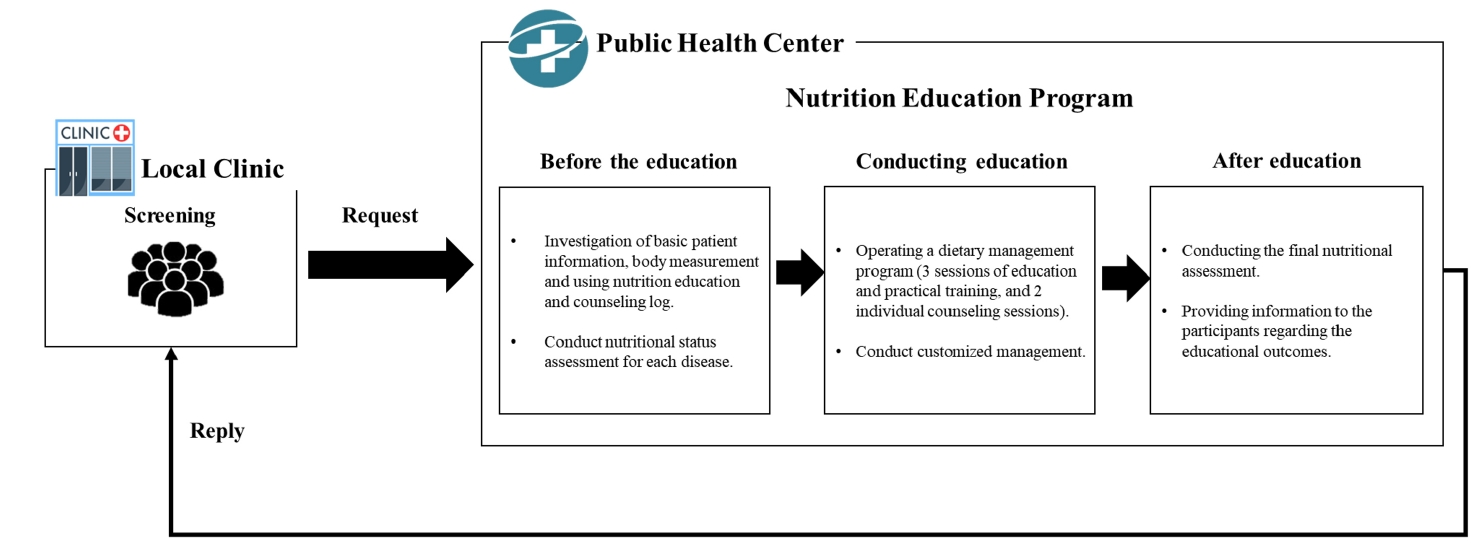
-
 Abstract
Abstract
 PDF
PDF PubReader
PubReader ePub
ePub - Objectives
We investigated the impact of an advanced “Nutrition Education Program” on patients with Diabetes mellitus, type 2 from public health centers enrolled in a primary health care-based chronic disease management project. This 12-week dietary management program was developed by the Korea Health Promotion and Development Institute. We assessed if this program improved glycemic control and other health indicators through dietary and nutritional improvements.
Methods
Seventeen patients with Diabetes mellitus type 2 were enrolled in the “Nutrition Education Program.” These patients were referred to public health centers for lifestyle management based on physician assessments at local clinics that were participating in a pilot project on primary health care-based chronic disease management. The participants attended the program comprising face-to-face basic, in-depth, and practical training sessions at the health center during the third, fifth, and seventh weeks, respectively. Anthropometric measurements, body composition analysis, blood biochemical characteristics, nutritional knowledge, and self-efficacy evaluation were performed before and after the program. Data were analyzed using SPSS ver. 28.0.
Results
The mean age of the participants was 62 years, and most participants were female (14, 82.4%). No significant changes in patients’ anthropometric measurements or body composition were observed after the training. However, significant reductions were observed in the blood biochemical characteristics, including glycated hemoglobin, total cholesterol, and low-density lipoprotein levels. Additionally, patients’ nutritional knowledge and self-efficacy scores increased significantly.
Conclusions
The “Nutrition Education Program” helped in improving glycemic control and other health indicators in patients with Diabetes mellitus type 2. Further research is required to objectively confirm the long-term and sustained effects of the program in a controlled study. Trial Registration Clinical Research Information Service Identifier: KCT0010010
- 1,404 View
- 60 Download

- [Korean]
- Food purchase patterns, food policy recognition, and food environment satisfaction among adults in Jeju, Korea, according to food security: a cross-sectional study
- Sumin Kim, Youjeong Jang, Hyunji Ham, Hanbin Ko, Insuk Chai, Kyungho Ha
- Korean J Community Nutr 2024;29(5):406-417. Published online October 31, 2024
- DOI: https://doi.org/10.5720/kjcn.2024.00012
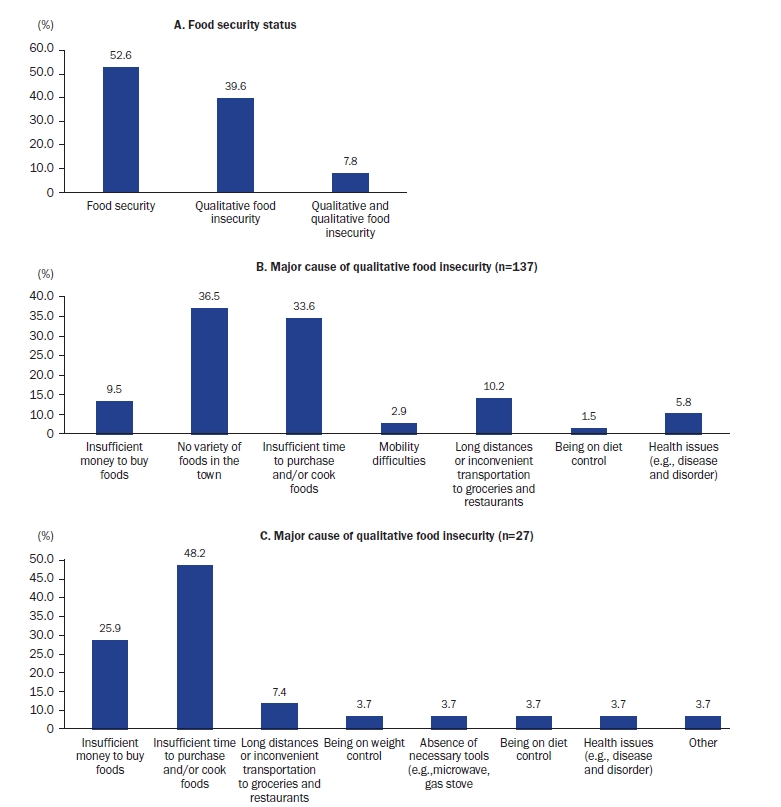
-
 Abstract
Abstract
 PDF
PDF Supplementary Material
Supplementary Material PubReader
PubReader ePub
ePub - Objectives
Recently, food insecurity has been a major public health issue along with the food crisis caused by COVID-19, climate change, and the polarization of food supply due to socioeconomic disparities. Food insecurity is known to be related to the food choices and environment of the consumer. Therefore, this study aimed to evaluate the food security statuses of adults in Jeju and investigate their food purchase patterns, food policy recognition, and food environment satisfaction.
Methods
Based on data from the 2022 Jeju Food Survey, 346 adults aged ≥19 years in Jeju were classified into food security and insecurity groups (quantitatively and qualitatively) using the questionnaire. Food purchase patterns, including purchasing frequency, items, and reasons, were surveyed for local and eco-friendly foods. The recognition and necessity of several food policies and satisfaction with diet and food environment (availability, accessibility, affordability, accommodation, and acceptability) were measured using the Likert scale.
Results
Among the total participants, 47.4% were in the food insecurity group. The frequency of purchasing local and eco-friendly foods did not significantly differ by food security status. The insecurity group exhibited a higher recognition rate of basic rights to food (36.0%) than the security group (24.7%, P = 0.023). The recognition and necessity of specific food policies did not significantly differ by food security status, except for the policy of promoting food communities, for which the food security group exhibited higher recognition than the food insecurity group did (P = 0.004). The food insecurity group exhibited significantly lower scores regarding satisfaction toward diet and food environment factors (P < 0.05 for all).
Conclusions
Overall, the food security group reported higher satisfaction with their diet and food environment than the food insecurity group. Further in-depth studies to investigate the determinants of food insecurity and effective promotional strategies for food policies are needed.
- 1,444 View
- 48 Download

- [Korean]
- An educational needs analysis of sustainable dietary education for nutrition teachers: an application of the IPA, Borich needs assessment and The locus for focus model
- Eunseo Yang, Borham Yoon
- Korean J Community Nutr 2024;29(5):372-381. Published online October 31, 2024
- DOI: https://doi.org/10.5720/kjcn.2024.00008
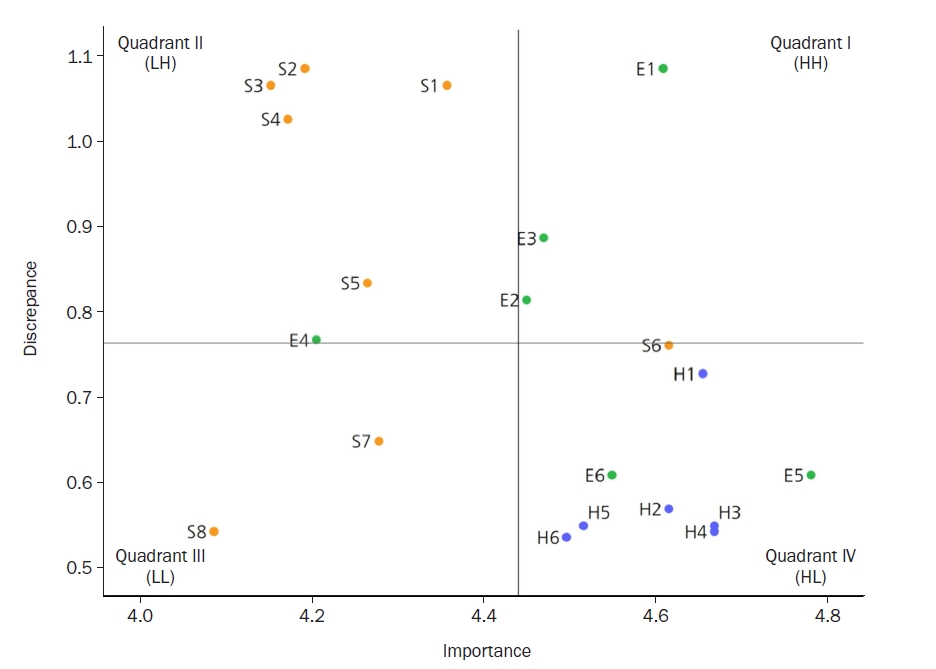
-
 Abstract
Abstract
 PDF
PDF PubReader
PubReader ePub
ePub - Objectives
This study aimed to investigate the importance and performance levels of sustainable dietary education across the health, environment, and society domains as perceived by nutrition teachers and evaluate the needs and priorities for sustainable dietary education.
Methods
An online survey was conducted for 151 nutrition teachers in Jeollanam-do. The survey included 20 questions across the health, environment, and society domains. The data were analyzed using a paired-sample t-test, the importance-performance analysis (IPA), the Borich needs assessment model, and the locus for focus model.
Results
Overall, the average importance levels of the 20 items of sustainable dietary education were significantly higher than their average performance levels (4.44 vs. 3.68). The examination of each educational domain revealed that although the importance of education in the health domain was recognized and actively practiced by the nutrition teachers, the performance was comparatively lower in the environment and society domains. The Borich needs assessment and the locus for focus model identified education on biodiversity conservation, plant-based protein, and the use of local food as the top-priority group in the environment domain along with fair and ethical food, food security, regional food culture, food policy and trade, and family dining culture as the second-priority group in the society domain.
Conclusions
The results of this study underscore the need to support the nutrition teachers’ perception and practice of sustainable dietary education in the environment and society domains. We believe that the educational needs and priorities proposed in this study will be considered in the future development and modification of sustainable dietary education programs. -
Citations
Citations to this article as recorded by- Analysis of pork consumption attribute factors by consumer lifestyle in Korea: a cross-sectional study
Jounghee Lee, Juhyun Lee, Wookyoung Kim
Korean Journal of Community Nutrition.2025; 30(1): 75. CrossRef - An Exploratory Study on the Necessity and Promoting Strategies for School-Based Dietary Education: Focus Group Interviews with Home Economics Teachers
Seung Jae Lee, Ji Eun Oh, Kyung Won Lee
Human Ecology Research.2025; 63(1): 41. CrossRef - Analysis of students’ need for artificial intelligence content in the 「Digital education」 subject
SungAe Kim, Ji Won You
The Journal of Korean Association of Computer Education.2025; 28(7): 71. CrossRef - Safety education status and needs priorities of Korean military food service personnel using the Borich Needs Assessment and the Locus for Focus model: a cross-sectional study
Jeongeun Park, Eunsil Her
Korean Journal of Community Nutrition.2025; 30(4): 261. CrossRef
- Analysis of pork consumption attribute factors by consumer lifestyle in Korea: a cross-sectional study
- 1,767 View
- 64 Download
- 4 Crossref

- [English]
- Analysis of health behavior changes among residents in depopulation areas in Korea: a cross-sectional study based on Community Health Survey data from 2010 to 2019
- Miyong Yon
- Korean J Community Nutr 2024;29(4):348-357. Published online August 31, 2024
- DOI: https://doi.org/10.5720/kjcn.2024.00001
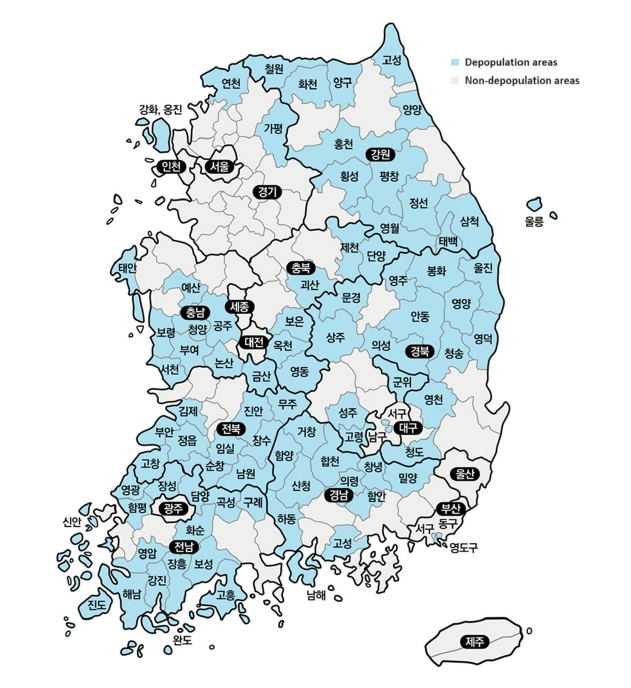
-
 Abstract
Abstract
 PDF
PDF PubReader
PubReader ePub
ePub - Objectives
The total population of Korea began to decline in 2019; in particular, the population in rural areas has been rapidly decreasing and is aging. Therefore, the government has designated depopulation areas and is seeking ways to support them. To assess whether health disparities exist between areas with population decline and those without, this study used community health survey data to observe temporal changes in health behaviors between the two types of areas. Methods: The analysis used Community Health Survey data from 2010 to 2019, and regional classification was divided by depopulation areas designated by the Ministry of the Interior and Safety. Trends in health behavior and chronic disease prevalence between depopulation and non-depopulation areas were analyzed. All analyses were conducted using complex sample analysis procedures in SAS 9.4 software. Results: The smoking rate steadily decreased in both depopulation and non-depopulation areas, whereas the high-risk drinking rate increased slightly. The walking practice rate did not improve in depopulation areas compared to non-depopulation areas. Furthermore, nutritional labeling usage rate was consistently lower in depopulation areas than in non-depopulation areas, with the gap being the largest. The prevalence of obesity, diabetes, and hypertension showed that the gap between depopulation and non-depopulation areas is continuously increasing. Conclusions: Health behaviors in depopulation areas have not improved, and the prevalence of chronic diseases is increasing rapidly. Therefore, the demand for health care services that support healthy lifestyle practices and chronic disease management in these areas is expected to increase.
- 1,426 View
- 20 Download

- [Korean]
- Comparative study on the health and dietary habits of Korean male and female adults before and after the coronavirus disease 2019 pandemic: utilizing data from the 8 th Korea National Health and Nutrition Examination Survey (2019–2021)
- Chaemin Kim, Eunjung Kim
- Korean J Community Nutr 2024;29(1):65-80. Published online February 29, 2024
- DOI: https://doi.org/10.5720/kjcn.2024.29.1.65
-
 Abstract
Abstract
 PDF
PDF - Objectives
This study aims to compare changes in physical factors, health behaviors, eating habits, and nutritional intake among Korean male and female adults over a period of three years (2019–2021) before and after the outbreak of coronavirus disease 2019 (COVID-19).
Methods
This study utilized raw data from the 8th Korea National Health and Nutrition Examination Survey (2019–2021). The participants in this study included 6,235 individuals in 2019, 5,865 individuals in 2020, and 5,635 individuals in 2021. Individuals whose daily energy intake was less than 500 kcal or exceeded 5,000 kcal were excluded from the study.
Results
In comparison to 2019, overweight/obesity rates, weight, waist circumference, weekend sleep hours, and resistance exercise days/week increased in both male and female during the COVID-19 pandemic. Regarding eating habits, the proportions of people skipping breakfast, not eating out, consuming health supplements, and recognizing nutritional labels increased in 2020 and 2021, whereas the rate of skipping dinner decreased. Total energy intake has continued to decrease for the two years since 2019. A comparison of nutrient intake per 1,000 kcal before and after the outbreak of COVID-19 revealed that intake of nutrients, including protein, phosphorus, iron, vitamin A, riboflavin, and niacin increased, while folic acid intake decreased. In male, calcium, phosphorus, riboflavin, and niacin intakes increased, whereas iron, vitamin C, and folic acid intakes decreased. In female, phosphorus, iron, vitamin A, and riboflavin intake increased significantly, while protein and niacin intake decreased significantly.
Conclusions
After COVID-19, the obesity rate, breakfast skipping rate, health supplement intake, and nutritional label use increased, while the frequency of eating out, dinner skipping rate, and total energy intake decreased. These environmental changes and social factors highlight the need for nutritional education and management to ensure proper nutritional intake and reduce obesity rates in the post-COVID-19 era. -
Citations
Citations to this article as recorded by- Status of Use of Protein Supplement Products according to the Health Concerns of Adults in Their 20s and 30s
Cho-In Oh, Bok-Mi Jung
Journal of the East Asian Society of Dietary Life.2025; 35(1): 9. CrossRef - A study on regional differences in dietary behaviors and satisfaction in Korea focusing on urban and rural comparisons: a cross-sectional study
Jong-Youn Rha, Sohyun Kim, Hae-Rang Lee, Juhyeon Kil
Korean Journal of Community Nutrition.2025; 30(2): 140. CrossRef - How Did the Dietary Behavior of Older Korean Adults Change During the COVID-19 Pandemic?
Yong-Seok Kwon, Dasol Kim, Hee-Sook Lim
Nutrients.2025; 17(12): 1973. CrossRef - Intake of energy and macronutrients according to household income among elementary, middle, and high school students before and during the COVID-19 pandemic: a cross-sectional study
Chae-Eun Jeong, Heejin Lee, Jung Eun Lee
Korean Journal of Community Nutrition.2024; 29(3): 234. CrossRef - 성인 남녀의 먹방 시청시간에 따른 식행동에 대한 연구
하얀 남, 복미 정, 은례 전
Korean Journal of Food and Cookery Science.2024; 40(4): 275. CrossRef
- Status of Use of Protein Supplement Products according to the Health Concerns of Adults in Their 20s and 30s
- 3,711 View
- 69 Download
- 5 Crossref

- [Korean]
- Effectiveness of NQ-E index-based individual nutrition counseling for community-care elderly: an intervention study on improving nutritional status, complex chronic diseases, and quality of life
- Yoonjeong Choi, Jihyun Lee, Heesook Lim, Yoo Kyoung Park
- Korean J Community Nutr 2023;28(6):480-494. Published online December 31, 2023
- DOI: https://doi.org/10.5720/kjcn.2023.28.6.480
-
 Abstract
Abstract
 PDF
PDF - Objectives
This study sought to assess the effectiveness of community-based nutrition counseling on improving nutritional status, managing complex chronic diseases, and enhancing the quality of life for elderly individuals with chronic conditions, particularly in older adults with high levels of food insecurity and multiple chronic illnesses.
Methods
Thirty elderly subjects with diabetes and hypertension who were registered at local Senior Welfare Center received individualized nutrition counseling, based on their Nutrition Quotient for the Elderly (NQ-E) index. Over a 16-week period, they received tailored counseling and underwent various health and nutritional assessments. The final analysis included 28 participants after two dropped out. Data analysis was conducted using the SPSS v28.0.
Results
The subjects were over 70, with multiple chronic diseases including diabetes and hypertension and predominantly female. After 16 weeks, significant improvements were observed in the subjects’ grip strength, and HbA1c levels, as well as in their NQ-E scores, indicating improved dietary balance and diversity. There were no significant improvements in the ‘Moderation’ subdomain of the NQ-E index, suggesting that this aspect requires further attention in nutritional counseling. The subjects' nutritional risk scores (NSI) were also significantly decreased, indicating less nutritional risk. Lastly, as measured by the SF-36K, the subjects’ quality of life showed significant improvement in several domains including physical role performance and social function.
Conclusions
This study demonstrates that tailored nutrition counseling, based on the NQ-E index, can improve elderly health, manage chronic diseases, and enhance quality of life. This approach potentially broadens the scope of community nutritionists' roles within an aging society. However, additional research is necessary to evaluate these interventions' long-term effects and sustainability. -
Citations
Citations to this article as recorded by- A Basic Study to Establish a Nutrition Education System for Welfare Facilities for the Elderly at Home Using Body Composition Analysis and Nutritional Management Cards
Sun Hee Lee, Seung-Lim Lee
The Korean Journal of Community Living Science.2024; 35(3): 471. CrossRef
- A Basic Study to Establish a Nutrition Education System for Welfare Facilities for the Elderly at Home Using Body Composition Analysis and Nutritional Management Cards
- 1,149 View
- 47 Download
- 1 Crossref

- [Korean]
- Process evaluation of a mobile healthcare program among employees with overweight and obesity: a 12-week intervention study investigating the role of engagement
- Imhuei Son, Jiyoun Hong, Young Hee Han, Bo Jeong Gong, Meng Yuan Zhang, Woori Na, Cheongmin Sohn, Taisun Hyun
- Korean J Community Nutr 2023;28(6):466-479. Published online December 31, 2023
- DOI: https://doi.org/10.5720/kjcn.2023.28.6.466
-
 Abstract
Abstract
 PDF
PDF - Objectives
A mobile health intervention program was provided for employees with overweight and obesity for 12 weeks, and a process evaluation was completed at the end of the program. We investigated participant engagement based on app usage data, and whether engagement was associated with the degree of satisfaction with the program.
Methods
The program involved the use of a dietary coaching app and a wearable device for monitoring physical activity and body composition. A total of 235 employees participated in the program. App usage data were collected from a mobile platform, and a questionnaire survey on process evaluation and needs assessment was conducted during the post-test.
Results
The engagement level of the participants decreased over time. Participants in their 40s, high school graduates or lower education, and manufacturing workers showed higher engagement than other age groups, college graduates, and office workers, respectively. The overall satisfaction score was 3.6 out of 5. When participants were categorized into three groups according to their engagement level, the upper group was more satisfied than the lower group. A total of 71.5% of participants answered that they wanted to rejoin or recommend the program, and 71.9% answered that the program was helpful in improving their dietary habits. The most helpful components in the program were diet records and a 1:1 chat with the dietary coach from the dietary coaching app. The barriers to improving dietary habits included company dinners, special occasions, lack of time, and eating out. The workplace dietary management programs were recognized as necessary with a need score of 3.9 out of 5.
Conclusions
Participants were generally satisfied with the mobile health intervention program, particularly highly engaged participants. Feedback from a dietary coach was an important factor in increasing satisfaction. -
Citations
Citations to this article as recorded by- Application of a living lab model to an evidence-based reduced-sodium healthy eating practice program in Korea: a pre-post study
Jung-Hyun Kim, Eugene Shim, Min Sook Kyung, Sooyoun Kwon, Hyoung su Park, Jae-Heon Kang
Korean Journal of Community Nutrition.2025; 30(1): 53. CrossRef
- Application of a living lab model to an evidence-based reduced-sodium healthy eating practice program in Korea: a pre-post study
- 865 View
- 59 Download
- 1 Crossref

- [Korean]
- Health behaviors and eating habits in people’s 20s and 30s according to food content usage level on social media: a cross-sectional study
- Seo-Yeon Bang, Bok-Mi Jung
- Korean J Community Nutr 2023;28(5):392-403. Published online October 31, 2023
- DOI: https://doi.org/10.5720/kjcn.2023.28.5.392
-
 Abstract
Abstract
 PDF
PDF - Objectives
This study was intended to investigate adults’ health behaviors and eating habits according to their levels of social media use.
Methods
From May 27 to July 11, 2022, an online survey was conducted of 452 male and female social media users in their 20s and 30s, and their eating habits and health behaviors were compared and analyzed according to their degree of social media use. For each of the three levels of food content use, the frequency of social media content use, and the total score range of average social media viewing time per day were divided into three parts, and a group with a score of less than 2 points was classified as low-use; a group with a score of 2 or more and less than 3 points was classified as middle-use; and a group with a score of 3 points or more was classified as high-use.
Results
The use of food content was higher in women than in men (P < 0.001), and higher in those in their 20s than in those in their 30s (P < 0.001). The group with a high level of food content use showed a higher rate of post-use hunger than the group with a low level (P < 0.01). The experience of eating after using food content was also higher in the group with a high level of use than in the group with a low level of use (P < 0.001). The group with a normal or high level of food content use had more negative eating habits than the group with a low level.
Conclusions
The study highlighted the need to provide desirable food content to people in their 20s and 30s with negative eating habits and to promote them so that they can use the right healthy nutrition–related content. -
Citations
Citations to this article as recorded by- The relationship between smartphone usage and eating behavior for elementary school students in Gangneung, South Korea: cross-sectional study
Minji Kim, Meera Jang
Korean Journal of Community Nutrition.2024; 29(4): 278. CrossRef
- The relationship between smartphone usage and eating behavior for elementary school students in Gangneung, South Korea: cross-sectional study
- 2,633 View
- 74 Download
- 1 Crossref

- [Korean]
- Association between health financial capacity of local governments and health behaviors of local residents: a cross-sectional study
- Miyong Yon
- Korean J Community Nutr 2023;28(2):95-103. Published online April 30, 2023
- DOI: https://doi.org/10.5720/kjcn.2023.28.2.95
-
 Abstract
Abstract
 PDF
PDF - Objectives
The budget gap in the health sector of local governments affects the supply of health services, which can cause the health gap. This study classified local governments according to their financial characteristics, such as local financial independence and health budget level. It analyzed the health behaviors and disease prevalence of local residents to examine the effect of local government financial investment on the health of local residents.
Methods
To classify types according to the financial characteristics of local governments, financial independence and the health budget data for 17 local governments were collected from the local fiscal yearbook of the Ministry of Public Administration and Security. The prevalence of chronic diseases and healthy behavior was compared using the 16,333 data of adults between the ages of 30 and 65 years among the original data of the National Health and Nutrition Examination Survey (2016–2020).
Results
Cluster analysis was used to classify local governments into five clusters according to the health financial capacity type. A comparison of the prevalence of local residents by cluster revealed a similar prevalence of hypertension, diabetes, and hypercholesterolemia. On the other hand, the obesity rate (P < 0.01), high-risk drinking rate (P < 0.01), aerobic physical activity rate (P < 0.001), and healthy eating practice rate (P < 0.001) were significantly different. In addition, an analysis of the odds ratio based on the Seoul area revealed a higher risk of health behavior of non-Seoul residents.
Conclusions
It is necessary to review the universal health promotion project budget considering the degree of regional financial vulnerability from the viewpoint of health equity to narrow the health gap among regions.
- 847 View
- 24 Download

- [English]
- Effectiveness of a mobile health intervention on weight loss and dietary behavior changes among employees with overweight and obesity: a 12-week intervention study investigating the role of engagement
- Imhuei Son, Jiyoun Hong, Young-Hee Han, Bo Jeong Gong, Meng Yuan Zhang, Woori Na, Cheongmin Sohn, Taisun Hyun
- Korean J Community Nutr 2023;28(2):141-159. Published online April 30, 2023
- DOI: https://doi.org/10.5720/kjcn.2023.28.2.141
-
 Abstract
Abstract
 PDF
PDF - Objectives
This study aimed to determine whether a mobile health (mhealth) intervention is effective in reducing weight and changing dietary behavior among employees with overweight and obesity. The study also investigated whether engagement with the intervention affected its effectiveness.
Methods
The intervention involved the use of a dietary coaching app, a wearable device for monitoring physical activity and body composition, and a messenger app for communicating with participants and an intervention manager. A total of 235 employees were recruited for a 12-week intervention from eight workplaces in Korea. Questionnaire surveys, anthropometric measurements, and 24-h dietary recalls were conducted at baseline and after the intervention.
Results
After the intervention, significant decreases in the mean body weight, body mass index, body fat percentage, and waist circumference were observed. Furthermore, the consumption frequencies of multigrain rice and legumes significantly increased, whereas those of pork belly, instant noodles, processed meat, carbonated beverages, and fast food significantly decreased compared with those at baseline. The mean dietary intake of energy and most nutrients also decreased after the intervention. When the participants were categorized into three groups according to their engagement level, significant differences in anthropometric data, dietary behaviors, and energy intake were observed following the intervention, although there were no differences at baseline, indicating that higher engagement level led to greater improvements in weight loss and dietary behavior.
Conclusions
The intervention had positive effects on weight loss and dietary behavior changes, particularly among employees with higher engagement levels. These results indicate the importance of increasing the level of engagement in the intervention to enhance its effectiveness. The mhealth intervention is a promising model for health promotion for busy workers with limited time. -
Citations
Citations to this article as recorded by- Improving the nutrition quotient and dietary self-efficacy through personalized goal setting and smartphone-based nutrition counseling among adults in their 20s and 30s
Dahyeon Kim, Dawon Park, Young-Hee Han, Taisun Hyun
Journal of Nutrition and Health.2023; 56(4): 419. CrossRef - Process evaluation of a mobile healthcare program among employees with overweight and obesity: a 12-week intervention study investigating the role of engagement
Imhuei Son, Jiyoun Hong, Young Hee Han, Bo Jeong Gong, Meng Yuan Zhang, Woori Na, Cheongmin Sohn, Taisun Hyun
Korean Journal of Community Nutrition.2023; 28(6): 466. CrossRef - Systematic Review on the Study of the Childhood and Adolescent Obesity in Korea: Dietary Risk Factors
Eun Jeong Heo, Jae Eun Shim, Eun Young Yoon
Korean Journal of Community Nutrition.2017; 22(3): 191. CrossRef
- Improving the nutrition quotient and dietary self-efficacy through personalized goal setting and smartphone-based nutrition counseling among adults in their 20s and 30s
- 1,141 View
- 42 Download
- 3 Crossref

- [English]
- Changes in dietary habits and chronic diseases before and after COVID-19 by regions using data from the 2018-2020 Korea Community Health Survey and Consumer Behavior Survey for Foods: a cross-sectional study
- Surim Park, Eun-hee Jang, Seungmin Lee
- Korean J Community Nutr 2023;28(2):124-140. Published online April 30, 2023
- DOI: https://doi.org/10.5720/kjcn.2023.28.2.124
-
 Abstract
Abstract
 PDF
PDF - Objectives
This study examined the changes in dietary habits, the prevalence of chronic diseases, and mental health problems in the regional areas of the Republic of Korea before and after the COVID-19 pandemic to provide evidence of the status of regional health inequalities.
Methods
This study analyzed Korean adults aged 19 or older who participated in the Korea Community Health Survey (n = 686,708) and Consumer Behavior Survey for Foods (n = 19,109) from 2018 to 2020. The participants were classified according to their residence area (Seoul metropolitan area, Metropolitan cities, Provinces); 2018-2019 were defined as before COVID-19, and 2020 as after COVID-19. The dietary behaviors, chronic diseases, and mental health problems were measured using a self-report questionnaire.
Results
After COVID-19, the eating-out usage rate in the Seoul metropolitan area and Provinces decreased compared to before COVID-19 (P < 0.001), and when responding that they eat out, the frequency of eating out with household members in the Seoul metropolitan area increased (P = 0.024). The deliveries/takeout usage rate in the Provinces decreased after COVID-19 compared to before (P < 0.001). After COVID-19, the prevalence of obesity decreased in all regions (P < 0.001), and the prevalence of hypertension increased significantly in the Provinces (P = 0.015). The prevalence of diabetes mellitus increased continuously before and after COVID-19 in all regions (P < 0.002). High-risk subjective stress levels increased significantly in the Seoul metropolitan area (P < 0.001), and sleep duration significantly increased in all regions (P < 0.001). Major depressive disorder was reduced significantly in Metropolitan cities (P = 0.042) and Provinces (P < 0.001).
Conclusions
After the COVID-19 pandemic, the prevalence of chronic diseases and mental health problems showed regional differences along with changes in dietary habits. It is necessary to reflect the regional differences in dietary habits in future policies resolving regional health inequalities.
- 806 View
- 14 Download

- [Korean]
- Comparison of the Nutrient Intake and Health Status of Elderly Koreans According to their BMI Status: Focus on the Underweight Elderly Population
- You-Sin Lee, Yoonna Lee
- Korean J Community Nutr 2022;27(5):422-434. Published online October 31, 2022
- DOI: https://doi.org/10.5720/kjcn.2022.27.5.422
-
 Abstract
Abstract
 PDF
PDF - Objectives
With an increase in the population of the elderly in Korea, their nutritional status has become a cause for concern. This study was designed to compare the nutritional intake and health status of the Korean elderly according to their body mass index.
Methods
The subjects were 3,274 elderly people aged 65 and above who had participated in the 2016-2018 Korea National Health and Nutrition Examination Survey. The subjects were divided into four groups: underweight, normal, overweight, and obese, based on their BMI. The general characteristics, daily energy, and nutrient intakes, nutrient intakes compared to the recommended nutrient intake, percentage of participants whose nutrient intake was lower than the estimated average requirement (EAR), index of nutrient quality, the mean adequacy ratio (MAR), intakes by food group, and health status of the four groups were compared.
Results
Underweight elderly people showed lower energy, lipids, dietary fiber, vitamin C, riboflavin, niacin, phosphorus, sodium, and potassium intake and MAR score (P < 0.001) compared to the normal or obese elderly. The mean protein, riboflavin, niacin, vitamin C, phosphorus, and iron intake of the underweight elderly was lower than the EAR (P < 0.05). Underweight elderly people also had a lower intake of vegetables and fats, oil and sweets food groups than the other groups (P < 0.001). The prevalence of diabetes and dyslipidemia was higher in the obese group, but the percentage of anemia was higher in the underweight group.
Conclusions
Underweight elderly people were vulnerable to undernutrition and were at a higher risk of anemia. -
Citations
Citations to this article as recorded by- Exploring the Association Between Older Adults’ Body Mass Index and Their Fall Experience, Chronic Diseases, and Exercise Frequency: Evidence from Korea
Daekeun Kwon, Su-Yeon Roh, Jeonga Kwon
Medicina.2025; 61(9): 1622. CrossRef - Effect of physical activity on free fatty acids, insulin resistance, and blood pressure in obese older women
Woo-Hyeon Son, Min-Seong Ha, Tae-Jin Park
Physical Activity and Nutrition.2024; 28(2): 1. CrossRef - Determinants of Length of Stay for Medical Inpatients Using Survival Analysis
Jaekyeong Kim, Haegak Chang, Seiyoung Ryu, Ilyoung Choi, Angela Eunyoung Kwon, Haeyong Ji
International Journal of Environmental Research and Public Health.2024; 21(11): 1424. CrossRef - The Relationship of Pork Meat Consumption with Nutrient Intakes, Diet Quality, and Biomarkers of Health Status in Korean Older Adults
Ah-Jin Jung, Anshul Sharma, Mei Chung, Taylor Wallace, Hae-Jeung Lee
Nutrients.2024; 16(23): 4188. CrossRef
- Exploring the Association Between Older Adults’ Body Mass Index and Their Fall Experience, Chronic Diseases, and Exercise Frequency: Evidence from Korea
- 2,185 View
- 46 Download
- 4 Crossref

- [Korean]
- Effect of Type of Nutrition Labeling on the Healthfulness Evaluation and Purchase Intentions of Home Meal Replacements (HMR) in South Korea
- Mee-Young Joe
- Korean J Community Nutr 2022;27(5):387-396. Published online October 31, 2022
- DOI: https://doi.org/10.5720/kjcn.2022.27.5.387
-
 Abstract
Abstract
 PDF
PDF - Objectives
The purpose of this study was to examine the effects of the types of nutrition labeling on the processing fluency, health evaluation and purchase intentions of home meal replacements.
Methods
This online experimental study was conducted from December 29 to 31, 2019 and included 134 participants. The research design was 2 (Objective nutrition labeling: present vs. absent) X 2 (Evaluative nutrition labeling: present vs. absent) and each participant was randomly assigned to one of four groups. As stimuli, five types of ready-to-heat foods sold in the market were used.
Results
Processing fluency (4.91 points) and purchase intention (4.13 points) were significantly high when both evaluative nutrition labeling and objective nutrition labeling were presented, and healthfulness evaluation (4.47 points) was significantly high when only evaluative nutrition labeling was presented. All three variables were measured to be high when evaluative nutrition labeling was presented. The evaluative nutrition labeling that visually represented nutritional values was found to be more effective for processing fluency, healthfulness evaluation, and purchase intention than the objective nutrition labeling representing the nutritional value of the product in numbers and proportions.
Conclusions
These results show that it is necessary to develop various types of evaluative nutrition labeling to enable consumers to choose and purchase healthful home meal replacements. Also, consumer education and public campaigns are needed to encourage consumers to select healthier home-cooked meals using nutrition labeling. -
Citations
Citations to this article as recorded by- Analysis of Dietary Behavior and Sustainable Dietary Life Competency in Families According to Parents’ Dietary Lifestyle: Using the 2021 Korea Consumer Behavior Survey for Food
Sun A Choi, Jeong Ok Rho
Journal of the Korean Society of Food Science and Nutrition.2023; 52(11): 1179. CrossRef - Study on the consumption practices and Importance-Satisfaction Analysis of meal-kit selection attributes among adults in their 20s and 30s
Se-Eun Kim, Hyun-Joo Bae
Journal of Nutrition and Health.2023; 56(3): 315. CrossRef
- Analysis of Dietary Behavior and Sustainable Dietary Life Competency in Families According to Parents’ Dietary Lifestyle: Using the 2021 Korea Consumer Behavior Survey for Food
- 673 View
- 17 Download
- 2 Crossref

- [Korean]
- Consumption Values of Fast Food according to Health Consciousness in American Consumers
- Kiwon Lee, Youngmi Lee
- Korean J Community Nutr 2022;27(4):309-320. Published online August 31, 2022
- DOI: https://doi.org/10.5720/kjcn.2022.27.4.309
-
 Abstract
Abstract
 PDF
PDF - Objectives
This study aimed to analyze the consumption values of fast foods among American consumers and compare the consumption values according to the levels of health consciousness.
Methods
An online survey using a self-administered questionnaire was conducted on 351 American consumers. Based on the median health consciousness score (3.83 out of 5 points), the subjects were classified into the low health-conscious group (Low group) and the high health-conscious group (High group). Factor analysis was used to extract factors for the five consumption values (functional, social, emotional, conditional, and epistemic values). The differences in the consumption values between the two groups were analyzed.
Results
A total of 14 factors were extracted for the five consumption values and 9 factors among them (convenience, healthiness, and taste in functional values; health-conscious people, young, busy, obese people, low class, and budget restricted people in social values; guilt in emotional values; accidental situations in conditional values) showed significant differences between the two groups. The Low group had a higher perception of the factor of healthiness (P < 0.001) than the High group. The High group had a relatively higher perception of the factors of convenience (P < 0.001), taste (P < 0.001), and guilt (P < 0.001). In addition, the High group perceived the social values of fast foods more negatively. The High group consumed fast foods less frequently than the Low group and perceived their health status and healthiness of eating habits more positively.
Conclusions
The results reveal that the health consciousness level significantly influences consumption value perceptions about fast foods in American consumers. Policymakers and marketers can develop effective strategies based on the results of this study.
- 726 View
- 43 Download

- [Korean]
- Program Evaluation using the RE-AIM Framework: A Systematic Review and Application to a Pilot Health Promotion Program for Children
- Ji-Eun Lee, Jae Eun Shim, Kirang Kim, Jae-Heon Kang, Ji-Yun Hwang
- Korean J Community Nutr 2022;27(4):296-308. Published online August 31, 2022
- DOI: https://doi.org/10.5720/kjcn.2022.27.4.296
-
 Abstract
Abstract
 PDF
PDF - Objectives
This study aimed to develop evaluation criteria for the elementary-school-based health promotion program using the RE-AIM framework and to examine their feasibility.
Methods
Previous evaluation studies on health interventions for elementary-school students using the RE-AIM framework were reviewed systematically to identify appropriate evaluation criteria. A diet and physical activity intervention based on the transtheoretical model was implemented in a pilot study using the “Happy Me” application. The feasibility of using the RE-AIM framework to evaluate it was examined.
Results
The review yielded the following evaluation criteria: “reach,” the ratio of participants out of the total target population; “efficacy/effectiveness,” the difference in outcomes between the intervention and control groups, or between a pre- and post-test; “adoption,” the rate of use of the program and participation in the next stage of the program; “implementation,” the progress on the program components; “maintenance,” the participants’ and teachers’ intention to continue using the program. The pilot study reached 76.6% of the targeted population. The intake of sugar-sweetened beverages decreased (P < 0.0001), and the duration of walking increased (P < 0.0001). Other indicators could not be evaluated; therefore, potential indicators were suggested.
Conclusions
This study produced feasible evaluation criteria for elementary-school-based health promotion using the RE-AIM framework. Nevertheless, the feasibility needs to be validated with a broader range of studies and long-term interventions.
- 921 View
- 19 Download

- [Korean]
- Dietary Status of Preterm Infants and the Need for Community Care
- Ji Su Jeon, Won Hee Seo, Eun mi Whang, Bu Kyung Kim, Eui Kyung Choi, Jang Hoon Lee, Jeong Hee Shin, Young Shin Han, Sang-Jin Chung
- Korean J Community Nutr 2022;27(4):273-285. Published online August 31, 2022
- DOI: https://doi.org/10.5720/kjcn.2022.27.4.273
-
 Abstract
Abstract
 PDF
PDF - Objectives
This study compared the nutritional intakes of early and late preterm infants in a neonatal intensive care unit (NICU) and at home. The dietary problems and the need for community care services for premature infants were further investigated.
Methods
This is a cross-sectional and descriptive study on 125 preterm infants and their parents (Early preterm n = 70, Late preterm n = 55). The data were collected by surveying the parents of preterm infants and from hospital medical records.
Results
No significant differences were obtained between the early and late preterm infant groups when considering the proportion of feeding types in the NICU and at home. Early preterm infants were fed with a greater amount of additional calories at home and had more hours of tube feeding (P = 0.022). Most preterm infants had feeding problems. However, there was no significant difference between early and late preterm infants in the mental pain of parents, sleeping, feeding, and weaning problems at home. Many parents of preterm babies had no external support, and more than half the parents required community care to take care of their preterm babies.
Conclusions
Regardless of the gestational age, most preterm infants have several problems with dietary intake. Our study indicates the need to establish community care services for preterm infants.
- 507 View
- 10 Download

- [Korean]
- Dietary Behaviors Associated with Health Perception of Korean Adolescents from Multicultural Families: based on data from the 2017 ~ 2019 Korea Youth Risk Behavior Surveys
- YueRong Hu, SuJin Song
- Korean J Community Nutr 2022;27(3):192-204. Published online June 30, 2022
- DOI: https://doi.org/10.5720/kjcn.2022.27.3.192
-
 Abstract
Abstract
 PDF
PDF - Objectives
This study examined the association between dietary behaviors and perceived health status among Korean adolescents from multicultural families.
Methods
This cross-sectional study included 2,459 Korean adolescents from multicultural families (aged 13 ~ 18 years) who participated in the 2017 ~ 2019 Korea Youth Risk Behavior Surveys. Information on the sociodemographic variables, dietary behaviors, and lifestyle variables was selfreported using a web-based questionnaire. The dietary behaviors analyzed in this study were the breakfast and food intake frequencies, including fruit, vegetable, milk, fast food, carbonated drink, sweet drink, and high caffeine/energy drinks. The adolescents’ health perception was self-rated as healthy, average, or unhealthy. The dietary behaviors associated with health perception were examined using a multiple logistic regression after adjusting for the confounding variables.
Results
In this study population, 7.6% of adolescents perceived their health status as unhealthy, and 25.4% perceived it as average. The adolescents who were girls, middle school students, and in households with a low economic status showed significantly higher percentages of poor health perception (P-values < 0.001). Skipping breakfast was significantly associated with a negative health perception. Compared to the adolescents who consumed fruits every day, those who did not consume fruits during the previous week showed a higher odd ratio (OR) for a negative health perception [OR = 2.29, 95% confidence interval (CI) = 1.32–3.97]. The adolescents who frequently consumed carbonated drinks ( 5 times/week) perceived their health status as unhealthy relative to those who did not consume carbonated drinks (OR = 2.15, 95% CI = 1.25–3.71). Skipping breakfast was significantly associated with an increased OR for a negative health perception in girls but not in boys. Compared to adolescents with a normal weight, those with overweight/ obesity (OR = 1.75, 95% CI = 1.21–2.52) and underweight (OR = 2.19, 95% CI = 1.25–3.82) showed higher ORs for negative health perception. Positive associations of overweight/obesity and underweight with negative health perception were observed in boys but not in girls.
Conclusions
Dietary behaviors and weight status were associated with the health perception in Korean adolescents from multicultural families. These findings suggest that nutrition interventions on breakfast intake and healthy food choices for this population might effectively improve their weight and perceived health status. -
Citations
Citations to this article as recorded by- The unequal weight of COVID-19 pandemic: national trends in body mass index among Korean adolescents by immigrant-origin and gender from 2013 to 2022
Nari Yoo, Yumin Hong, Yoonyoung Choi
International Journal of Adolescence and Youth.2024;[Epub] CrossRef
- The unequal weight of COVID-19 pandemic: national trends in body mass index among Korean adolescents by immigrant-origin and gender from 2013 to 2022
- 759 View
- 17 Download
- 1 Crossref

- [Korean]
- Association Between Health Literacy and Health Promoting Behavior (Eating Habits, Physical Activity, and Stress) of University Students
- Yoon-Sun Kim
- Korean J Community Nutr 2022;27(2):94-104. Published online April 30, 2022
- DOI: https://doi.org/10.5720/kjcn.2022.27.2.94
-
 Abstract
Abstract
 PDF
PDF - Objectives
This study attempted to examine the association between health literacy and health-promoting behavior, and identify the major variables that affect the health-promoting behavior of university students.
Methods
This was a descriptive correlation study that identified the degree of health literacy and health-promoting behavior of 248 university students (119 male and 129 female) and examined the correlation between the two and factors influencing them. The questionnaire covering health literacy comprised 66 questions, and that for health-promoting behavior comprised 10 questions covering eating habits, 3 questions about physical activity, and 10 questions involving stress.
Results
The score for health literacy was 41.56 ± 18.38 out of 66 points, and that for health-promoting behavior was 65.27 ± 11.21 points (27.61 ± 6.72 points for eating habits, 7.23 ± 2.56 points for physical activity, and 30.44 ± 5.61 points for stress). Health literacy and health-promoting behavior had a significant positive correlation (r = 0.175, P < 0.01). The perceived health status (β = 0.391,P < 0.001) was the most important variable in healthpromoting behavior, followed by health literacy (β = 0.236, P < 0.001).
Conclusions
It is necessary to develop a systematic educational strategy and implement educational programs to improve health literacy as well as encourage health-promoting behavior and thus increase the perceived health levels of university students. -
Citations
Citations to this article as recorded by- Differences in Nutritional Status According to the Residence Types among University Students in Gwangju
Geum-Bi Ryu, Young-Ran Heo
Journal of the Korean Society of Food Science and Nutrition.2024; 53(2): 207. CrossRef
- Differences in Nutritional Status According to the Residence Types among University Students in Gwangju
- 904 View
- 21 Download
- 1 Crossref

- [Korean]
- Consumption of Weight-control or Health Functional Foods, Dietary Habits, and Weight Perceptions According to the Body Mass Index of Adult Women in the Chungcheong Area
- Gayoung Seong, Munkyong Pae
- Korean J Community Nutr 2022;27(2):81-93. Published online April 30, 2022
- DOI: https://doi.org/10.5720/kjcn.2022.27.2.81
-
 Abstract
Abstract
 PDF
PDF - Objectives
This study was conducted to investigate the experience and perception among adult women regarding weight control and the consumption of weight-control foods or health functional foods based on their body mass index (BMI).
Methods
The subjects were 634 adult women from the Chungcheong province, Korea, and data were collected through a self-administered questionnaire from July 2021 through September 2021. The subjects were divided into four groups based on their BMI status: underweight (< 18.5 kg/㎡ , 7.6%), normal weight (18.5 ~ 22.9 kg/㎡ , 53.3%), overweight (23 ~ 24.9 kg/㎡ , 19.7%), and obese ( ≥ 25 kg/㎡ , 19.4%).
Results
Over the past 3 years, almost two-thirds (68.6%) of the adult women had tried weight control measures, despite the fact that a significant proportion of them were normal or underweight. More importantly, 57.6% of subjects reported the consumption of weightcontrol foods, with a lower proportion in the underweight (35.4%) group compared to the normal (56.2%), overweight (62.4%), and obese (65.0%) groups. The food items used for weight control were mostly salads, chicken breasts, low fat (soy) milk, slimming tea, protein shakes, low-calorie cereals, and energy/protein bars among others. In addition, one-third (31.1%) of the subjects reported the use of health functional foods containing ingredients for fat reduction. A significantly higher proportion of these was from the overweight (36.0%) and obese (38.2%) groups compared to the underweight (20.8%) and normal weight (28.1%) groups. Products containing Garcinia cambogia extract, green tea, or Cissus extract, were popular among users. Subjects who were obese had a poorer perception of their health and body. Most subjects felt the need for correct information regarding weight control, but this number was significantly more in the higher BMI groups.
Conclusions
Our results suggest that the use of weight-control foods or health functional foods is popular among adult women, especially those who are obese. Thus, nutrition education courses covering facts about weight control and practice need to be developed and provided based on the BMI status of subjects. -
Citations
Citations to this article as recorded by- Consumption of protein supplements/protein-fortified foods among young adults in Jeju
Hyoju Lee, Youjeong Jang, Sumin Kim, Kyungho Ha
Journal of Nutrition and Health.2024; 57(2): 261. CrossRef - Prediction model of weight control experience in men with obesity in their 30 s and 40 s using decision tree analysis
Myeunghee Han
Scientific Reports.2024;[Epub] CrossRef - A Study on Diet Perceptions and Trends Before and After COVID-19 Using Big Data Analysis
Eunjung Lee, Hyosun Jung, Jina Jang
Journal of the Korean Society of Food Science and Nutrition.2023; 52(6): 659. CrossRef - A Narrative Approach to the Diet History of Female College Students : Focusing on the Role of SNS and Social Media Influencers and Individuals’ Motivation for Dieting
Kyungbo Kim
Korean Journal of Journalism & Communication Studies.2022; 66(3): 139. CrossRef
- Consumption of protein supplements/protein-fortified foods among young adults in Jeju
- 1,109 View
- 19 Download
- 4 Crossref


 KSCN
KSCN

 First
First Prev
Prev



